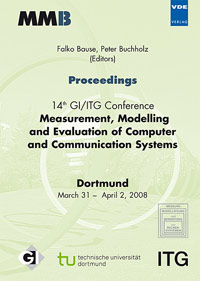The DISCO Network Calculator
Conference: MMB 2008 - 14th GI/ITG Conference - Measurement, Modelling and Evalutation of Computer and Communication Systems
03/31/2008 - 04/02/2008 at Dortmund, Germany
Proceedings: MMB 2008
Pages: 3Language: englishTyp: PDF
Personal VDE Members are entitled to a 10% discount on this title
Authors:
Gollan, Nicos; Zdarsky, Frank A.; Martinovic, Ivan; Schmitt, Jens B. (Distributed Computer Systems Lab (DISCO), Technische Universität Kaiserslautern)
Abstract:
Network calculus was developed for use in IP and ATM networks. It aims to be a system theory for deterministic queuing, allowing to derive deterministic guarantees on throughput and delay, as well as find bounds on buffer sizes and thereby allow for loss-free transfer. Traditional queuing theory analyzes the average or equilibrium behavior of a network, whereas network calculus shows the worst observable case. It describes network traffic and services in terms of curves, wide-sense increasing functions that represent accumulated data. By using a min-plus algebra, replacing the addition and multiplication in (R,+, ·) by minimum and addition (R,min,+), it avoids non-linearities in the required operations on those curves. Similar to traditional system theory, network calculus provides a concatenation result, thereby making it possible to reduce tandems of systems (respective services) to a single equivalent service. An extension of the network calculus, the sensor network calculus, provides results for handling cross-traffic in networks with tree topologies that are typical for sensor networks. More recent results handle effects like data scaling, which is an effect in networks that not only forward data, but also mutate it along the path. This may be the result of compression, aggregation, or other processing.


